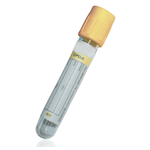Suitable Specimen Types
- Serum
Sample Processing in Laboratory
No special transport requirementsSample Preparation
Centrifuge sample upon receipt and separate serum.Turnaround Time
1 WeekSample Stability
4ºCMacroprolactin Screening Test
General Information
Prolactin can occasionally be present in serum in a macromolecular complex. The most common form is macroprolactin, an antibody-antigen complex of prolactin and immunoglobulin G with a molecular mass of 150-170kDa. Macroprolactin can be detected by the prolactin assay but is cleared more slowly than prolactin from the circulation leading to an apparent hyperprolactinaemia.
Macroprolactin has minimal bioactivity in-vivo, which is thought to be due to the failure of the high-molecular mass complex to cross capillary membranes to reach the prolactin receptors. It is important macroprolactin is identified when it is the cause of apparent hyperprolactinaemia to avoid diagnostic confusion and possible inappropriate treatment.
All samples with prolactin greater than 700 mU/L are automatically tested for macroprolactin unless clinical details indicate a known cause for elevation, e.g. prolactinoma.
Repeat testing is not indicated if the patient has been tested for macroprolactin within the last 12 months and the total prolactin result has not significantly changed.
The sample is put through Polyethylene Glycol (PEG) precipitation which physically removes the protein-complexed prolactin. The sample is then reanalysed for prolactin. Those where the results are significantly different are said to have macroprolactin present.
Reporting of Post PEG monomeric Prolactin level helps in identifying true monomeric (biologically active) hyperprolactinaemia from macroprolactinaemia (biologically inactive) to avoid potential misdiagnosis and mismanagement.
Patient Preparation
None
Reference Range
Reference ranges for Monomeric Prolactin are as follows:Male: 32-309 mIU/L
Female: 39-422 mIU/L
Specifications
- EQA Scheme?: No
- EQA Status: No scheme available
